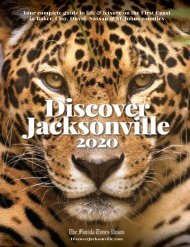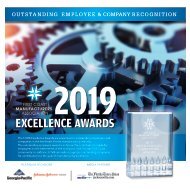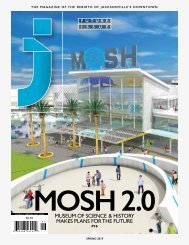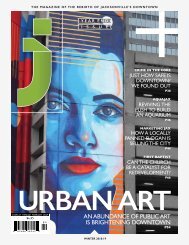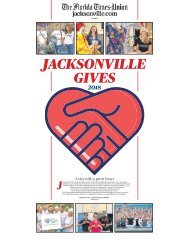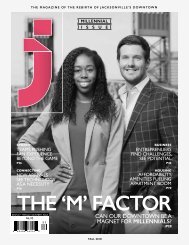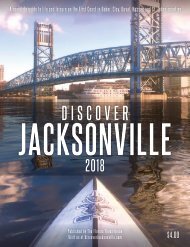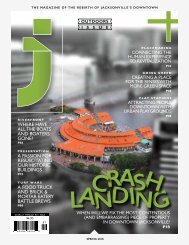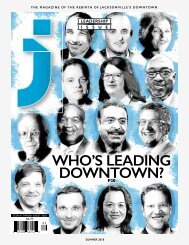HealthFeb2016
You also want an ePaper? Increase the reach of your titles
YUMPU automatically turns print PDFs into web optimized ePapers that Google loves.
FLORIDA RETINA INSTITUTE<br />
PROVIDING<br />
COMPASSIONATE CARE<br />
SINCE 1979 By Nan Kavanaugh<br />
Florida Retina Institute is special because its doctors share the goal of always providing excellent cuttingedge<br />
clinical care in an atmosphere with sincere compassion. Since they have offices from central Florida to<br />
south Georgia, they are unique in their ability to provide comprehensive retinal coverage for the entire region<br />
unlike any other practice in the area.<br />
Dr. James Staman<br />
founded the Florida<br />
Retina Institute. “My<br />
professional inspiration<br />
came from my father<br />
who was an ophthalmologist. Once<br />
I was exposed to retinal surgery, the<br />
procedures and outcomes were so<br />
exciting that I was convinced retina<br />
surgery was what I needed to do.<br />
What really excites me the most is<br />
experiencing the profound evolution<br />
of technology for repair of retinal<br />
detachments and diabetic retinopathy.<br />
This month we are proud to be<br />
participating in our third national study.<br />
This investigation is to evaluate a<br />
revolutionary ocular implant for longterm<br />
treatment of macular degeneration.<br />
We are now able to save sight for many<br />
people that otherwise would have been<br />
blind even 10 years ago.”<br />
His son, Dr. Jonathan Staman, joined<br />
the practice three years ago. Aside from<br />
being inspired by his father’s dedication<br />
to his work, he knew firsthand how<br />
vision loss can be detrimental. “I<br />
have a strong family history of retinal<br />
disease. I’ve seen family members lose<br />
their vision to retinal disease and the<br />
profound impact that vision loss can<br />
have on life,” Dr. Jonathan Staman says.<br />
Retina specialists see patients who have<br />
no one else to turn to when faced with<br />
blindness. Vision loss is one of the most<br />
devastating experiences a person can<br />
go through. “Few factors are as tied to<br />
quality of life as vision. Being able to<br />
help my patients maintain their sight in<br />
the face of serious ocular disease is why<br />
I love being an ophthalmologist and<br />
particularly a retinal specialist,” says Dr.<br />
Jonathan Staman.<br />
It is not every day you go to visit<br />
your doctor, and he walks into the room<br />
dressed in a tuxedo. Dr. Elias Mavrofrides<br />
dressed in a shirt and tie every day at the<br />
start of his tenure at the Florida Retina<br />
Institute twelve years ago. As the years<br />
progressed, he found it more sensible<br />
to wear scrubs to work since he was<br />
going from clinic directly to surgery. One<br />
day, one of his longstanding patients<br />
mentioned that she missed his more<br />
formal attire. “At her next appointment, I<br />
made it a point to wear a tuxedo, when I<br />
came into see her,” says Dr. Mavrofrides.<br />
“She couldn’t have been more pleased<br />
and took a photo to mark the occasion.<br />
We continue to be a leader in the field<br />
here because of our dedication to patient<br />
care. We always have and always will<br />
treat our patients like family.”<br />
As a physician, when you have a<br />
personal connection to the diseases you<br />
treat, you can provide an unparalleled
understanding when working with<br />
patients. His colleague Dr. Thomas<br />
Barnard also comes from a family with<br />
careers in the field of eye care. While<br />
that gave him the foundation to pursue<br />
work in the profession, what made him<br />
choose to become a retina specialist is<br />
his passion for the dynamic nature of the<br />
field. “I come from a long family history<br />
of eye care, I guess you can say it was in<br />
my blood. Retina is a very challenging,<br />
exciting, yet rewarding field.”<br />
Recognizing the overwhelming stress<br />
patients cope with when facing severe<br />
vision loss, the team at Florida Retina<br />
Institute strives to create an atmosphere<br />
of comfort and support. Dr. Steven<br />
Houston joined the practice last summer,<br />
and aside from the advanced technology<br />
and procedures being offered, the quality<br />
of patient care is what ultimately made<br />
him decide to join the practice. “I visited<br />
and was drawn to the family atmosphere,<br />
not only amongst physicians and the<br />
staff, but the whole organization. I didn’t<br />
find that at the other practices I had<br />
looked at,” he says. “We provide the<br />
same quality of care that the best large<br />
institutions provide, but we treat our<br />
patients like family. All of our staff has an<br />
understanding that we want to provide<br />
the best experience, as well as the best<br />
care possible.”<br />
The physicians at Florida Retina<br />
Institute have trained at the best<br />
institutions in the world, and the quality<br />
of care provided within their practice is a<br />
testimony to their expertise. Dr. William<br />
Dunn joined the practice in 1991, and<br />
he has been rated a Top Doctor by US<br />
News & World Report every year since<br />
1999. “This honor is a testimony to<br />
the good work done at Florida Retina,<br />
because you are chosen by your peers.<br />
You cannot be self-elected, and I feel<br />
honored that others in my field entrust in<br />
the care that I provide,” says Dr. Dunn.<br />
Research, clinical trials, and state of the<br />
art technology are used to give patients<br />
access to world class care across North<br />
Florida, Central Florida, and Georgia<br />
at Florida Retina Institute, while also<br />
providing excellent patient-centered<br />
experience. Utilizing<br />
technology, like an<br />
App that allows for<br />
home vision testing<br />
is one example<br />
of the patient-first<br />
philosophy of Florida<br />
Retina Institute. A<br />
patient can check<br />
their own vision every day and the<br />
results are automatically entered into<br />
a portal that can detect a decrease in<br />
vision loss and immediately alert their<br />
physician. Timely intervention is key<br />
to the success of many treatments of<br />
retinal medicine, and the physicians<br />
of the Florida Retina Institute are<br />
laser focused on providing the most<br />
up-to-date procedures and technology<br />
available for its patients. Research is<br />
a key component to this facet of the<br />
practice.<br />
“Retina is a very dynamic field and<br />
there have been so many changes,<br />
that being involved in research<br />
and clinical trials allows us to be at<br />
the forefront of the field,” says Dr.<br />
Matthew Cunningham who has been<br />
with the practice for three years. Dr.<br />
Cunningham graduated from medical<br />
school with Honors in research<br />
after spending time at the National<br />
Institute of Health, and subsequently<br />
went on to receive numerous awards<br />
during medical school, residency,<br />
and fellowship training for research<br />
projects. “Florida Retina Institute<br />
embraced my desire to not only<br />
provide excellent patient care, but also<br />
my desire to enhance the field of retina<br />
through research.”<br />
It is not just being at the forefront<br />
here in North Florida, but across the<br />
globe where the physicians of the<br />
Florida Retina Institute make an impact<br />
with their expertise. Dr. Dunn has<br />
provided his services to developing<br />
nations through numerous mission<br />
trips. “Florida Retina Institute works<br />
diligent with the community and public<br />
to promote eye care and health,” says<br />
Dr. Dunn.<br />
The practice’s newest member, Dr.<br />
Benjamin Thomas, hopes to bring<br />
more charitable work opportunities to<br />
the practice. “I’ve been afforded some<br />
unique opportunities to work with<br />
doctors and non-profit organizations<br />
doing incredible things in the<br />
developing world, and as I continue to<br />
work with these projects I hope it will<br />
provide one more interesting facet to<br />
this already-talented group of people,”<br />
says Dr. Thomas.<br />
Giving the gift of sight is an<br />
extraordinary mission, and the<br />
physicians and team at Florida Retina<br />
Institute cherish the opportunity to<br />
provide that gift with a philosophy<br />
focused on compassionate care and<br />
respect. “We treat all of our patients how<br />
we would like to be treated ourselves,”<br />
says Dr. Raul Moreno. “We have almost<br />
no wait time, and we make sure our<br />
staff makes our patients’ visits as stress<br />
free as possible. We are a patient<br />
first centered practice, and we pride<br />
ourselves on that.”<br />
To schedule an appointment or<br />
for more information and full list<br />
of locations:<br />
800.237.3846<br />
floridaretinainstitute.com<br />
NORTH FLORIDA LOCATIONS:<br />
JACKSONVILLE<br />
2639 Oak Street<br />
Jacksonville, FL 32204<br />
904.387.5600<br />
8786 Perimeter Park Blvd<br />
Jacksonville, FL 32216<br />
904.997.9202<br />
PALATKA<br />
800 Zeagler Drive<br />
Suite 310<br />
Palatka, FL 32177<br />
386.325.2411<br />
ST. AUGUSTINE<br />
1100 Plantation Island Dr. S.<br />
Suite 130<br />
St. Augustine, FL 32080<br />
904.826.0663<br />
LAKE CITY<br />
265 SW Malone Street<br />
Lake City, FL 32025<br />
386.487.0090<br />
FERNANDINA BEACH<br />
6 South 14th Street<br />
Fernandina Beach, FL 32034<br />
904.387.5600
letter from the editor ••••<br />
EDITOR<br />
Nan Kavanaugh<br />
CREATIVE DIRECTOR / DESIGNER<br />
Christine Tarantino<br />
My best friend’s mother lost her vision at the age<br />
of 17 in a car accident.<br />
SALES MANAGER<br />
Sean Scullion<br />
DIRECTOR OF BUSINESS DEVELOPMENT<br />
Stephanie Calugar<br />
MARKETING CONSULTANTS<br />
Joy Bell<br />
Nikki Schonert<br />
EVENTS COORDINATOR / SOCIAL MEDIA<br />
Erin Colatrella<br />
COPY EDITOR<br />
Sarah Musil<br />
CONTRIBUTORS<br />
Bob Fernee<br />
Maggie FitzRoy<br />
Allie Olsen<br />
Jon Vredenburg, MBA,RD,CDE,CSSD,LD/N<br />
PRODUCTION COORDINATOR<br />
Melanie Frenzel<br />
Stock photography provided by Thinkstock<br />
HealthSourceMag.com<br />
HealthSource Magazine is published 12 times per year by Times-<br />
Union Media. Reprints are available – 1 Riverside Avenue,<br />
Jacksonville, FL 32202. ©2016 HealthSource Magazine. All<br />
rights reserved. The contents of this publication, including articles,<br />
may not be reproduced in any form without written permission<br />
from the publisher. Content of the contributing advertisers<br />
do not reflect the opinions of Times Union Media. Advertisers<br />
have proofed respective articles and content is assumed true and<br />
correct. HealthSource is not responsible for the care given by<br />
its advertisers. HealthSource is for informational purposes only<br />
and is not meant as medical advice. HealthSource believes that<br />
choosing a medical professional is a serious decision and should<br />
not be based solely on an advertisement.<br />
She lived in New York City as<br />
single 20-something, graduated<br />
from college, married and raised<br />
two beautiful daughters. Today,<br />
she is the grandmother of four.<br />
She is a tough, strong mother<br />
and an extraordinary woman<br />
with a tender touch. I remember<br />
meeting her for the first time. I<br />
was in college, and my friend<br />
brought me to visit her home<br />
in Greensboro, NC. When I met<br />
Linda, I walked through her<br />
farmhouse thinking, “How did<br />
this woman do it?”<br />
I have two daughters of my<br />
own now, and I think about<br />
how different my life would be<br />
if I lost my vision. As much as<br />
I would miss seeing the vibrant<br />
colors of everyday life, the act<br />
of trying to find my 5-yearold<br />
daughter’s shoe under the<br />
couch without eyesight would<br />
be a relentless challenge to<br />
my sanity. Vision is the sense<br />
we take for granted the most,<br />
because we rely on it the most.<br />
We don’t indulge in our view of<br />
the beauty that surrounds us in<br />
life, and we don’t take special<br />
care of our eyes unless they are<br />
causing us trouble. Our eyes are<br />
our windows to the world, and<br />
they deserve to be nourished<br />
and maintained.<br />
This issue of HealthSource<br />
Magazine explores the way vision<br />
affects our lives, both literally and<br />
figuratively. I hope you enjoy it,<br />
and this month if you don’t have<br />
time to “stop and smell the roses,”<br />
maybe just take a good, hard look<br />
at them. There is so much beauty<br />
to see living here on the First<br />
Coast. Enjoy it.<br />
Best,<br />
Nan Kavanaugh<br />
Editor, HealthSource Magazine<br />
nan.kavanaugh@morris.com<br />
4—HealthSource February 2016
14<br />
20<br />
February 2016<br />
contents<br />
Features<br />
28<br />
6—HealthSource February 2016<br />
14 Fighting for<br />
Sight<br />
A son’s genetic vision<br />
disorder inspired his<br />
mother to help find<br />
a cure<br />
20 A CEO’s Mindset<br />
on Giving Back<br />
Doug Baer discusses<br />
the value of charitable<br />
works<br />
28 How to Dine Out<br />
and Diet<br />
Don’t let a Valentine’s<br />
Day date night ruin<br />
your New Year’s<br />
resolutions<br />
BODY WORKS<br />
10 Best Foot Forward<br />
Mind over Body: Thought<br />
processes of endurance<br />
running<br />
18 Exercise of the Month<br />
Coming to grips with love<br />
handles<br />
SOUND MIND<br />
24 Healthy Minute<br />
How healthy is your heart?<br />
FRESH EATS<br />
26 What’s On Your Plate<br />
Carob vs. Chocolate<br />
32 Grow Your Own<br />
Jewel Carrots
Winner of<br />
MAGAZINE<br />
OF THE YEAR<br />
— Florida Magazine<br />
Association<br />
If you love the First Coast you will love reading First Coast Magazine.<br />
Through captivating storytelling and photography, we showcase the vibrant life of the First Coast.<br />
There is so much to explore here, and we want to connect you with the people and places that make<br />
this region extraordinary. If you are new to town, or have lived here generations,<br />
First Coast Magazine has something for everyone.<br />
SUBSCRIBE TODAY.<br />
Only $19.95 for a full year of award winning photography and content.<br />
firstcoastmag.com<br />
7—HealthSource December 2015
FIND IT<br />
Online<br />
/ healthsourcemagazine / healthsourcemag<br />
@healthsourcemag<br />
/ healthsourcemag<br />
BABY IT’S<br />
COLD OUTSIDE<br />
Okay, so maybe it isn’t that<br />
cold outside….we do live in<br />
Florida. Regardless of the<br />
weather, soups are a wonderful<br />
winter food. Visit us online for<br />
some seasonal soup recipes.<br />
Diet Friendly<br />
Restaurants<br />
Just because you are going on<br />
a date night for Valentine’s Day<br />
doesn’t mean you have to over<br />
indulge. Visit us online for a list<br />
of restaurants with some great<br />
low calorie options!<br />
8—HealthSource February 2016<br />
Eye Health Tips<br />
Like any other part of your body, your eyes<br />
deserve to be healthy. Visit us online for tips on<br />
what you can do every day to maintain<br />
eye wellness.<br />
NEW<br />
WEBSITE<br />
IN THE<br />
WORKS!<br />
We are giving our website an upgrade, so be on<br />
the lookout this month! Visit our Facebook page<br />
to share your thoughts on how we can make it a<br />
stronger site for you. We will be announcing our<br />
launch sometime in late February.<br />
HealthSourceMag.com<br />
Visit healthsourcemag.com for the rest of the story…
DETERMINATION<br />
Find Yours Again<br />
The word addiction can be uncomfortable and it is often difficult to tell<br />
when you’ve gone too far. The good news is one of the best centers for<br />
understanding alcohol and medication misuse is right here in Jacksonville.<br />
Call confidentially today and let us answer your questions.<br />
Lakeviewhealth.com/today or call 888.612.9248<br />
Come in and get our FREE 5 Step Fit Process, which includes a foot pressure<br />
test, GAIT Analysis, and running test! Or come to one of our FREE weekly<br />
group runs from our stores! Visit: www.1stplacesports.com for details!<br />
SIX<br />
STORE<br />
LOCATIONS<br />
Baymeadows: 3931 Baymeadows Rd, Jacksonville | (904) 731-3676<br />
San Marco: 2018 San Marco Blvd, Jacksonville | (904) 399-8880<br />
Town Center: 4870 Big Island Dr., Jacksonville | (904) 620-9991<br />
Jax Beach: 424 South 3rd St, Jacksonville Beach | (904) 270-2221<br />
Orange Park: 2186 Park Avenue, Orange Park | (904) 264-3767<br />
St. Augustine: 1000 S. Ponce de Leon Blvd., St Augustine | (904) 679-4237<br />
February 2016<br />
healthsourcemag.com—9
BODY WORKS • • • • Best Foot Forward<br />
“Preparation is first and foremost. Once the hard work of training has<br />
been done, competing at one’s maximum is possible.”<br />
— Jay Birmingham<br />
10—HealthSource February 2016
By Bob Fernee<br />
The thought processes of endurance running<br />
Poised on the starting line, certain things go through a marathon runner’s<br />
mind before the race. He thinks of everything it took to get there and how<br />
happy he will be when it’s all over. Mostly, he’ll pray that his endurance<br />
holds up.<br />
Endurance, is defined in the dictionary as “the power of enduring an<br />
unpleasant or difficult process or situation without giving way.” It’s a word<br />
synonymous with the marathon; a race once considered too long and too<br />
demanding for all but the toughest of runners.<br />
Through training, the body must be conditioned to meet the<br />
extraordinary challenge of running 26 miles. Those training miles are the<br />
miles that will sustain the runner during the race. They will not only<br />
provide physical endurance, but psychological strength as well.<br />
February 2016<br />
healthsourcemag.com—11
“In the middle and end stages of any long race, the desire to<br />
keep pushing erodes. How one keeps pushing is mysterious,<br />
since it is easy to back off or drop out. I guess the satisfaction of<br />
a completed race is worth the battle.”<br />
— Jay Birmingham<br />
Local distance runner and coach, Jay<br />
Birmingham says, “Preparation is first<br />
and foremost. Once the hard work of<br />
training has been done, competing at<br />
one’s maximum is possible.”<br />
When the going gets tough, how do<br />
they keep going?<br />
The effect that spectators have on<br />
marathoners cannot be overestimated,<br />
especially during the latter part of the<br />
race.<br />
Days before the race, runners will<br />
begin hydrating and building up their<br />
glycogen reserves by eating lots of<br />
carbohydrates. These will help them<br />
avoid hitting “the wall” late in the race.<br />
Pacing during the race is also critical,<br />
and they must not begin too fast.<br />
“In the middle and end stages of any<br />
long race, the desire to keep pushing<br />
erodes. How one keeps pushing is<br />
mysterious, since it is easy to back off<br />
or drop out. I guess the satisfaction of a<br />
completed race is worth the battle,”says<br />
Birmingham.<br />
Much of the struggle is mental.<br />
Runners train their brains to stay positive.<br />
They use “self talk” and work on their<br />
“inner voice.” If that voice tells them<br />
negative things, then it will only magnify<br />
fears and doubts. But if it tells them to<br />
be strong, relaxed and confident, then it<br />
will strengthen them.<br />
Distance runners think in the present<br />
and about the manageable. Running<br />
from mile 10 to 11 is “just one mile to<br />
run,” rather than, “oh no, 16 more miles<br />
to go!” It is a mindset as much as it is an<br />
act of pure physical endurance.<br />
12—HealthSource February 2016
“It is not too often one is able to<br />
offer a testimonial that completely<br />
exceeds one’s expectations.<br />
River Garden provided me with<br />
such professional and loving care<br />
that I now can enjoy a more normal<br />
lifestyle. I thank the entire staff<br />
for making this possible. “<br />
Private room for each Rehab client<br />
Private suites available<br />
Complimentary transportation to<br />
and from your referring physician<br />
follow-up appointments<br />
We also provide<br />
“I wish to convey the gratitude<br />
and applause I have for the<br />
superior care which I received at<br />
River Garden. I am grateful for<br />
the care which has re-launched<br />
me into a better tomorrow.”<br />
“The medical staff and therapist<br />
worked together to help me<br />
have a successful rehab. I'm so<br />
grateful for them all.”<br />
“My success in reaching my goals was<br />
due to the dedication of the staff. They<br />
became my family away from home. I<br />
could not have asked for more.”<br />
11401 Old St. Augustine Road • Jacksonville, FL 32258 • www.river garden.org/rehab 904 -886-8454<br />
HealthSource Magazine is Northeast Florida’s original and most widely distributed<br />
consumer health magazine. Learn how to be a healthier you with helpful recipes, exercises<br />
and stories that celebrate living a life of wellness here on the First Coast.<br />
PICK UP YOUR FREE COPY TODAY!<br />
healthsourcemag.com<br />
February 2016<br />
healthsourcemag.com—13
“Some people give up. But even people who<br />
are blind can be very productive people, and<br />
should be.”<br />
— Lisa Pleasants<br />
14—HealthSource January 2016
••••<br />
BODY WORKS<br />
FIGHTING FOR<br />
and Photographed<br />
by Maggie FitzRoy<br />
SIGHTWritten<br />
A son’s genetic vision disorder inspired<br />
his mother to help find a cure<br />
Lisa Pleasants grew up knowing that if she ever had a son, he would have a 50-50 chance<br />
of inheriting an eye disease that runs in her family. Called X-linked juvenile retinoschisis,<br />
the disorder, affects only boys, and causes damage to the retina, resulting in impaired<br />
vision. Her two brothers had it, as did a cousin. So three months after her son and only<br />
child, Brendon Cavainolo, was born, she had him tested for the condition, hoping to beat<br />
the odds. They didn’t.<br />
“<br />
I<br />
t was the worst day of my life,<br />
when I learned he had it,”<br />
Pleasants says of that day 17 years<br />
ago. She quickly accepted the<br />
situation, however, and raised<br />
Brendon to never let his vision impairment<br />
prevent him from doing whatever he<br />
wanted to do. Now a junior at Mandarin<br />
High School, Brendon is planning to<br />
become an aerospace engineer. In the<br />
upper 10 percent of his class, he excels<br />
in math and science, and even plans to<br />
apply to the Massachusetts Institute of<br />
Technology, “for fun,” he says. He’s on<br />
his school’s cross country and track teams.<br />
He also loves computers, all types of<br />
technology, science fiction, and plays bass<br />
guitar and writes songs for his teen band,<br />
Neurofrost.<br />
“Some people give up,” Pleasants says.<br />
“But even people who are blind can be<br />
very productive people, and should be.”<br />
While Brendon is conquering teendom,<br />
his mom is on a mission to help find a<br />
cure. She founded a local organization,<br />
MOMS for Sight, to raise money for<br />
research. A longtime member of the<br />
Jacksonville chapter of the Foundation<br />
Fighting Blindness, and currently its<br />
president, Pleasants founded MOMS for<br />
Sight in 2012 as a support organization.<br />
She realized that many other Foundation
Fighting Blindness members were<br />
also mothers of children with retinol<br />
degenerative diseases like her son’s, and<br />
that together they could raise even more<br />
money and awareness. That led to the<br />
formation of another support organization,<br />
Students for Sight, of which Brendon is a<br />
member.<br />
Brendon’s condition affects his central<br />
and peripheral vision, making everything<br />
look farther away, and causing some areas<br />
of his visual field to be missing altogether.<br />
He cannot drive, and only reads text in<br />
large print. He also uses a minocular, a<br />
binocular for one eye, in school, and has<br />
learned to not be shy about letting teachers<br />
know his special needs.<br />
“It teaches you to be an independent<br />
person,” he says. “You have to become a<br />
self advocate.”<br />
Brendon is on the front line of<br />
experimental treatments for his condition.<br />
He has been accepted for a gene therapy<br />
trial this year at Massachusetts Eye and<br />
Ear in Boston. Mother and son will travel<br />
there 12 times for an initial treatment and<br />
then for follow-up tests. The treatment,<br />
scheduled to take place this spring, will be<br />
“the scariest part,” Brendon says, because<br />
it will involve getting a shot in one of his<br />
eyes. “They will use a virus as a carrier to<br />
deliver a protein that my eye is missing.”<br />
Brendon has always had a positive<br />
attitude, Pleasants says. “When he was<br />
four, he would go around saying, ‘I want<br />
to be a rocket scientist,’ and he has never<br />
wavered.”<br />
He hoped a cure would be found before<br />
he was old enough to drive, but when<br />
one wasn’t, his hope still never wavered.<br />
Pleasants says she grew up not believing<br />
a cure would ever be possible for her<br />
family’s disease, but the mapping of the<br />
human genome changed that. While<br />
FOR MORE<br />
INFORMATION<br />
Visit momsforsight.org<br />
and studentsforsight.org<br />
to learn more about how<br />
to get involved with these<br />
incredible organizations.<br />
16—HealthSource February 2016
hopeful a cure will be soon found for<br />
X-linked juvenile retinoschisis, “I’m not just<br />
in it because my son has the disease,” she<br />
says. “I will keep going until everyone’s<br />
kids are free from these diseases.<br />
Hopefully that will happen in my lifetime.”<br />
So far MOMs on a Mission has raised<br />
almost $25,000 through area fundraisers,<br />
and will hold a Black Ties and Blindfolds<br />
gala in April. Attendees will wear<br />
blindfolds during part of the event to<br />
personally experience blindness.<br />
Brendon’s proud that his band,<br />
Neurofrost (a “geeky” term for brain<br />
freeze) will perform at Blackties and<br />
Blindfolds. The guest of honor will be<br />
Shannon Boye, the researcher who<br />
discovered the best virus to use in the<br />
gene therapy injections.<br />
In addition to raising money for<br />
research, Pleasants says she and Brendon<br />
also enjoy the social support among<br />
members of Moms for Sight and Students<br />
for Sight.<br />
While Pleasants grew up watching her<br />
brothers go on to lead successful lives,<br />
many parents are unprepared to deal with<br />
their children’s diseases, she says.<br />
“Acceptance is hard,” she says. “But<br />
there is a lot of support out there. It<br />
doesn’t make you weaker, it makes you<br />
stronger.”<br />
February 2016<br />
healthsourcemag.com—17
BODY WORKS • • • • Exercise of the Month<br />
COMING TO GRIPS WITH<br />
LOVE HANDLES<br />
By Bob Fernee<br />
The good tidings of the holidays always seem to bring out the<br />
“love handles,” those unwanted bulges on the sides of the waist.<br />
What can you do to help shrink that “muffin top” back before<br />
Spring sets in?<br />
Unfortunately, you’ll have to put down that Valentine’s Day box of<br />
chocolates and pick up a diet plan. This will mean healthy eating habits like<br />
salads, fruits, vegetables, and lean protein. Calories will have to be cut, along<br />
with carbohydrates, junk food and snacks. Cardio exercises such as running,<br />
walking and cycling will burn calories and speed up the metabolism.<br />
A study published in The European Journal of Clinical Investigation<br />
discovered that fat cells behave differently depending on their location on<br />
the body. Areas that store more stubborn fat, like the sides of the waist, have<br />
less blood flowing to them. This means there is less chance of the fat being<br />
released and used for energy. Increasing the blood flow to a target area helps<br />
to ignite fat loss.<br />
Not feeling the love for those handles? Try these targeted exercises to<br />
help slim your waistline.<br />
SEATED RUSSIAN TWISTS:<br />
Sit on floor with both legs bent. Extend both<br />
arms out in front with hands together. Keep feet<br />
on the floor. Lower-upper body backwards until<br />
the back is at a 45-degree angle to the floor.<br />
Rotate arms from side to side; repeat 20 times.<br />
For a tougher, more advanced move, raise feet a<br />
few inches off the floor.<br />
18—HealthSource February 2016
STANDING SIDE OBLIQUE CRUNCH:<br />
While standing on left leg, raise right leg out to<br />
the side with knee bent. Lift thigh until parallel to<br />
floor. Lower right foot back to the floor and repeat.<br />
Complete 20 reps, then switch sides.<br />
SIDE BENDS:<br />
Can be done with or without weight. While<br />
standing, position left hand on top of left<br />
shoulder. Hold right hand at right side (or<br />
holding weight). Lower body to the right, then<br />
return back to starting position. Repeat for 20<br />
reps, then change sides.<br />
Indoor air<br />
pollutants<br />
may be<br />
the cause<br />
of your<br />
allergies<br />
and<br />
asthma<br />
You may be breathing in mold, mildew,<br />
dust, bacteria, pollen and pet dander.<br />
If it’s in your house, it’s in your lungs!<br />
Call today to have your air quality tested<br />
and monitored, and learn about ways to<br />
eliminate pollutants from your home.<br />
Call Today!<br />
(904) 278-0339<br />
• Air Purifiers • Duct Cleaning<br />
• Attic Insulation<br />
• Heating and Cooling Sales,<br />
Service and Replacement<br />
February 2016<br />
healthsourcemag.com—19
20—HealthSource February 2016
•••• SOUND MIND<br />
A CEO’s Mindset on<br />
GIVING BACK<br />
Doug Baer discusses the value<br />
of charitable works<br />
By Nan Kavanaugh, Photography by Heather Blackwell<br />
Doug Baer is an exceptional man, but he doesn’t see it that way. As CEO of Brooks<br />
Rehabilitation, a non-profit that touches the lives of millions of people here on the First Coast,<br />
he works every day supporting the health community driven by a simple mantra: doing good<br />
by people makes you a better person. He serves on the board of a number of organizations<br />
including Dreams Come True, St. Pauls’ Parish, the Northeast Florida Health Exchange, the<br />
American Heart Association, as well as many others.<br />
“<br />
I<br />
think if you do give back, and try to stretch yourself to do good things, it<br />
comes back to you,” says Baer. “I have always believed that.” He joined<br />
the board of the First Coast chapter of the American Heart Association in<br />
2009, and currently serves as its chairman. This year the organization is<br />
honoring him and his wife Laura as the 2016 Heart Ball Honorees.<br />
“One of the reasons we are honoring Doug as the 2016 Heart Ball honoree is<br />
because of the growth of the organization under his leadership,” says Lisa Craig,<br />
communication director of the First Coast AHA.<br />
Much of that is due to his work at Brooks. As a nonprofit, Brooks works in<br />
collaboration across the health industry, providing support to all hospitals and<br />
many other institutions. It is that community spirit that inspires the work they do<br />
and has allowed him to implement AHA programming and advocacy throughout<br />
February 2016<br />
healthsourcemag.com—21
“I think if you do give back, and try to stretch yourself to do good things, it comes<br />
back to you. I have always believed that.”<br />
— Doug Baer<br />
medical facilities across the region.<br />
He also encourages his employees to<br />
commit themselves to supporting the<br />
AHA through participating in walks<br />
and other fundraising events, as well<br />
as other nonprofit organizations on the<br />
First Coast.<br />
“When we survey employees about<br />
why they join our organization, one of<br />
the top answers is our involvement in<br />
the community. It is more important to<br />
employees than most employers realize.<br />
They value working for a company<br />
that is engaged in the community,”<br />
says Baer.<br />
His wife Laura attributes their staff<br />
involvement to the fact that the AHA<br />
team makes their events such a great<br />
time. “The group of people that work<br />
with this organization is what makes<br />
everything a lot of fun. That is what I<br />
love about it. They have a lot of energy.<br />
They are on fire,” says Laura. “It<br />
is a national organization with a lot of<br />
relevance to our community, and it is<br />
their team that makes it that way.”<br />
Aside from the Heart Walk, Brooks<br />
creates a wide variety of ways for their<br />
staff to engage in fundraising efforts<br />
for local organizations like the Heart<br />
Walk from bake sales, to car washes,<br />
to karaoke in the cafeteria. “It is a<br />
team building experience for our employees.<br />
We all come together, and we<br />
really try to contribute to the mission<br />
of the AHA. It is fun, and for a good<br />
cause. And it builds team work and<br />
contributes to the culture we establish<br />
here,” says Baer.<br />
It can also help to alleviate stress,<br />
which is always a boon in the workplace.<br />
A 2013 study published from<br />
the Carnegie Mellon University in the<br />
journal Psychology and Aging shows<br />
that people over the age of 50 who<br />
spend time regularly doing volunteer<br />
work have lower blood pressure than<br />
those who did not. The researchers attributed<br />
this to that the subjects found<br />
volunteer work as a productive activity<br />
that reduced stress, and that stress is a<br />
22—HealthSource February 2016
major contributor to a variety of health<br />
problems. Another study published in<br />
2012 showed that one key contributor<br />
to positive health benefits derived from<br />
volunteering is that the volunteer is<br />
motivated by altruism, rather than personal<br />
gain. Supporting an organization<br />
that is meaningful to you makes the<br />
volunteer work more beneficial. The<br />
Baers recognize this and it is a driving<br />
factor in their work with the AHA.<br />
“The mission of the heart association<br />
impacts so many people. All of<br />
us in the health industry are dedicated<br />
to support its mission, and that is<br />
a big reason why I got involved,” he<br />
says. But there is also a more personal<br />
reason. Baer’s mother suffered a heart<br />
attack in her early seventies. Dealing<br />
with shortness of breath, she went<br />
to the doctor only to find herself in<br />
an operating room the next day. She<br />
had 90 percent blockage in an artery<br />
in her heart and had an emergency<br />
open-heart surgery. “She lived another<br />
twenty years after that,” says Baer. In<br />
a way, Baer’s work with the AHA is<br />
paying it forward.<br />
The great Greek philosopher Aristotle<br />
described the quest of life was “To<br />
serve others and do good.” Taking that<br />
as an essential truth of what it means<br />
to live a fulfilling and positive life as<br />
a human being, lets just say Doug<br />
and Laura Baer don’t just talk the talk.<br />
They walk the Heart Walk, as well as<br />
many others in our community.<br />
“We feel very fortunate in all the opportunities<br />
we have provided, and to<br />
give back to the nonprofits is just the<br />
right thing to do for the community,”<br />
says Baer.<br />
Your City.<br />
Your News.<br />
Your App.<br />
Download the new mobile app from the<br />
award-winning Florida Times-Union and<br />
Jacksonville.com for iPhone and Android.<br />
Then start enjoying the full range of<br />
up-to-the-minute news and information,<br />
anywhere and everywhere you are.<br />
It’s just that simple.<br />
www.jacksonville.com/app<br />
February 2016<br />
healthsourcemag.com—23
Healthy Minute • • • • SOUND MIND<br />
How Healthy is Your<br />
HEART<br />
Compiled by Nan Kavanaugh<br />
What do you do for your heart?<br />
Are you a good person that feeds their heart by doing good deeds?<br />
Are you a healthy person that gives to their heart through a tough cardio workout?<br />
Both are necessary to living a long, full life. Heart disease is the No. 1 killer in<br />
America. The American Heart Association is working hard to educate the public<br />
about how to make our hearts stronger through an initiative called My Life Check.<br />
You can go to their website at mylifecheck.org to take the quiz and find out where<br />
you rank when it comes to heart health. Here is a checklist for you to keep as a daily<br />
reminder of what you can do to keep your heart good and healthy.<br />
Manage Your<br />
Blood Pressure:<br />
There are a variety<br />
of places around<br />
town where you can<br />
go get your blood<br />
pressure checked for<br />
free. Most Walgreens<br />
offer this service.<br />
Control your<br />
Cholesterol:<br />
Stay away from<br />
eating too much of<br />
foods that are high<br />
in fat and calories.<br />
Reduce<br />
Blood Sugar:<br />
Diabetes is on the<br />
rise. Reduce your<br />
blood sugar by<br />
avoiding sweets, soda<br />
and foods that are<br />
high in sugar.<br />
Lose Weight:<br />
While dieting is one<br />
way to loose weight,<br />
exercise is the best.<br />
Get that blood<br />
pumping and burn<br />
some calories.<br />
Stop Smoking:<br />
There are so many<br />
tools out there<br />
to help you quit.<br />
Smokers have<br />
a higher risk of<br />
cardiovascular<br />
disease, so strive to<br />
curb your addiction.<br />
February 2016<br />
healthsourcemag.com—25
CAROB<br />
CHOCOLATE<br />
VS.<br />
26—HealthSource February 2016
What’s On Our Plate •••• FRESH EATS<br />
If you have been avoiding all forms of media for the past<br />
15 years, then it may come as a surprise to you that chocolate<br />
may impart some health benefits.<br />
By Jon Vredenburg, MBA,RD,CDE,CSSD,LD/N<br />
However, can the same be said for carob? Carob is the chocolate alternative that<br />
frequently turns up in many health food stores and may leave you wondering if it can<br />
compare to the powerhouse of chocolate.<br />
Carob is derived from pods of large evergreen trees,<br />
which are native to the Mediterranean region. Carob is<br />
also known as ‘St. John’s Bread,’ because St. John the<br />
Baptist allegedly survived in the wilderness by eating<br />
honey and carob bean pods. The pods contain an edible<br />
fruit that can also be roasted and ground into powder in<br />
a similar fashion as the cacao beans which give us cocoa,<br />
and ultimately chocolate. Carob has never been a common<br />
food, but it gained some popularity in the 1970s, when<br />
it began to be marketed as a “healthful” alternative to<br />
chocolate.<br />
The key nutritional difference between chocolate<br />
and carob is that there is no caffeine in carob. Carob is<br />
also lower in fat and contains more dietary fiber than<br />
cocoa. However, in terms of total calories, candies made<br />
with cocoa or carob are similar. They each require the<br />
addition of sugar and fat to neutralize their naturally bitter<br />
flavors. Nicole Woodsmall, a Registered Dietitian and<br />
Education Manager for the American Society for Preventive<br />
Cardiology, in Jacksonville, notes the limited benefit<br />
of using one over the other. “If you are trying to avoid<br />
caffeine, carob may offer benefits over eating chocolate.<br />
However, carob does not contain the same amount of<br />
flavonoids as chocolate, and carob also does not taste all<br />
that similar to chocolate,” says Woodsmall.<br />
Flavonoids are the healthful compounds found in<br />
chocolate, but they are not unique to the decadent treat.<br />
“Besides chocolate, flavonoids are found in a wide range of<br />
brightly colored fruits and vegetables: blueberries, plums,<br />
apples, cherries, oranges, strawberries, grapes. They are<br />
also found in nuts, red wine, soy products and tea,” says<br />
Woodsmall.<br />
The antioxidant activities of flavonoids appear to be what<br />
gives them many of their benefits. Flavonoid consumption<br />
has been linked to improvements in cholesterol levels and<br />
blood pressure, along with lower rates of heart disease.<br />
A 2014 study, published in the Journal of Nutrition, also<br />
found that consuming high levels of flavonoids may not<br />
only protect against heart disease, but also potentially<br />
lower the risk of developing type 2 diabetes.<br />
Although they are perceived to be similar, carob and<br />
chocolate have distinctively different flavors and textures.<br />
In fact, the main commonality between the two is their<br />
brown color. For anyone sensitive to the ingredients in<br />
chocolate, like caffeine, then carob offers a quasi-chocolate<br />
experience. However, if you are seeking a lower calorie<br />
alternative to the chocolate bar, be sure to read the labels<br />
closely to see exactly what you may be getting. Carob<br />
may leave you unsatisfied and to make matters worse, you<br />
would also be unable to tout the familiar health food perks<br />
bestowed upon a decadent piece of chocolate.<br />
February 2016<br />
healthsourcemag.com—27
28—HealthSource December 2015
•••• FRESH EATS<br />
HOW TO<br />
DINE OUT<br />
AND DIET<br />
Don’t let a Valentine’s Day date night ruin<br />
your New Year’s resolutions<br />
By Jon Vredenburg, MBA,RD,CDE,CSSD,LD/N<br />
The calendar has turned to February, and there is a good chance<br />
your New Year’s resolutions are still right next to you on<br />
your path to wellness.<br />
Or at the very least, they are still visible in your rear view mirror. No matter<br />
your situation though, dining out healthfully is as much of an art, as it is<br />
a science. The culinary riches which are present in many Valentine’s Day<br />
dining celebrations require calorie-conscious customers to strengthen<br />
their resolve. However, a few simple maneuvers through each course<br />
of the meal can help you stay on a path that is both reasonable and accommodating, which<br />
should make you happy.<br />
DRINKS<br />
Water is by far going to be your best choice when counting calories. However, celebratory<br />
meals are often synonymous with wine. The key tactic here is to strive for quality over<br />
quantity. Most wines will provide about 140 calories per 6 ounce glass. White wines tend<br />
to be lower in calories than red wines. The more wine you consume, the more difficult it<br />
will be to fulfill the rest of your sensible dining plan. Look closely at the alcohol by volume<br />
(ABV) numbers, as the higher percentage will have more calories. Aim to keep the ABV<br />
below 12% and aim to keep your glass on the table, more often than not.<br />
February 2016<br />
healthsourcemag.com—29
APPETIZERS<br />
Conventional wisdom says to skip this<br />
portion of the meal if you are truly calorieconscious,<br />
but if the appetizer is going to<br />
be a part of your dining experience look<br />
to share a lower-calorie option such as<br />
seared ahi tuna or shrimp. As long as they<br />
are not fried, or covered in butter, both<br />
choices weigh in at less than 35 calories<br />
per ounce. A garden salad is always a<br />
great option too, but just keep a close<br />
eye on what you add to the salad. Each<br />
tablespoon of shredded cheese or bacon<br />
bits adds another 30 calories and a modest<br />
2 Tablespoon serving of a creamy dressing<br />
pours on another 140 calories. For general<br />
reference, 2 Tablespoons is about the size<br />
of a ping pong ball.<br />
Bread and rolls are frequent<br />
accompaniments to a meal out on the<br />
town. Research shows that when food is<br />
placed in front of us, we are going to be<br />
compelled to eat again, regardless if we<br />
have just eaten. Put yourself in a better<br />
position to eat fewer calories by asking the<br />
wait staff not to bring bread to the table<br />
at all. If you really want hot bread, make<br />
yourself some toast for breakfast.<br />
MAIN COURSE<br />
The entrée is the culinary centerpiece of<br />
the meal. In most restaurant settings, this<br />
is typically a meat-centered dish. As with<br />
most things nutrition related, size matters.<br />
A steak portion can top over 16 ounces on<br />
some menus, so it would be wise to opt<br />
for the petit sirloin if you are compelled<br />
to choose red meat. For example, a<br />
16-ounce T-bone steak provides over 900<br />
calories, while a 6-ounce sirloin provides<br />
just 325 calories. Try to choose loin or<br />
round cuts of meat whenever possible.<br />
Try to choose loin or round cuts of meat<br />
whenever possible.<br />
30—HealthSource February 2016
Take heart<br />
too, because<br />
if dinner<br />
leads to a<br />
post-meal<br />
smooch, that<br />
kiss can burn<br />
a few extra<br />
calories<br />
while<br />
bringing<br />
a smile to<br />
your face.<br />
After all,<br />
being happy<br />
should be<br />
your ultimate<br />
goal.<br />
Fish dishes typically offer a wider array<br />
of lower calorie options on restaurant<br />
menus, followed closely by poultry. What<br />
you place on the item also matters a great<br />
deal to your waistline too. Béarnaise,<br />
hollandaise and other cream sauces can<br />
add another 50-60 calories per Tablespoon<br />
which is almost like pouring salad dressing<br />
all over your entrée.<br />
It is a forgone conclusion that any<br />
special occasion meal will likely exceed<br />
your average caloric intake. However,<br />
you can lessen the caloric excess by<br />
pairing your entrée with a non-starchy<br />
vegetable such as asparagus, broccoli or<br />
grilled seasonal vegetables. Most starchy<br />
side items such as potatoes and pasta will<br />
end up being vehicles for added fat and<br />
calories. A loaded baked potato will easily<br />
top over 400 calories, and a sweet potato<br />
with butter can be just as hefty.<br />
DESSERTS<br />
Part of the dining experience on<br />
a special occasion is sharing it with<br />
someone. If you decide to order a dessert,<br />
then sharing is a must. Look for desserts<br />
that feature fruit, as these are likely going<br />
to be lower in calories. Avoid desserts that<br />
are served with ice cream or chocolate<br />
sauce, as these normally have double the<br />
calories than a slice of pie or cake. Look<br />
out for menu descriptors like ‘explosion’ or<br />
‘avalanche’ too, as these typically are not<br />
reserved for lighter fare.<br />
Maximizing your dining experience<br />
while minimizing the calorie payload is not<br />
an easy task, but with a few adjustments<br />
it can be done. Take heart too, because if<br />
dinner leads to a post-meal smooch, that<br />
kiss can burn a few extra calories while<br />
bringing a smile to your face. After all,<br />
being happy should be your ultimate goal.<br />
February 2016<br />
healthsourcemag.com—31
FRESH EATS •••• Grow Your Own<br />
jewel<br />
carrots<br />
By Allie Olsen<br />
An easy choice to grow with kids<br />
My 8 year old is a jokester. He also dislikes vegetables. He’s not one of those<br />
spit it out and throw a tantrum in the middle of the restaurant kids, but he<br />
doesn’t get excited about them either. I’m using our family garden and a sense<br />
of humor as a way to teach him to love Florida fresh produce!<br />
32—HealthSource February 2016
805 Wells Road, Orange Park, FL 32073<br />
In-Demand Career Programs:<br />
• Medical Assistant<br />
• Medical Administrative Assistant<br />
• Medical Insurance Billing and Coding<br />
• Pharmacy Technician<br />
See what sets us apart:<br />
• Scholarships and grants available for<br />
those who qualify<br />
• Short-term programs with flexible<br />
schedules<br />
• Nonprofit status, meaning we can do<br />
more for our students<br />
For more information about graduation rates, the<br />
median debt of students who completed the program<br />
and other important information, please visit our<br />
website at www.everest.edu/disclosures.<br />
Call or visit us today.<br />
(904) 264-9122<br />
February is our region’s coldest<br />
time of the year, but it is a fruitful<br />
time in the garden. Cold days offer<br />
bug-free soil prep and a great chance<br />
to prep for the spring planting. We<br />
cover dormant beds with heavy black<br />
plastic to keep additional weeds from<br />
sprouting and focus attention on a<br />
few winter crops.<br />
This month, plant jewel carrots.<br />
Carrots, like stubby Thumbelinas and<br />
brightly colored jewel carrots, thrive<br />
in the cool weather and will be ready<br />
in time for Easter dinner. The tops are<br />
edible when stirred into a hearty winter<br />
stew, and they are an excellent source<br />
of Vitamin A.<br />
Beach Boulevard: 14444 Beach Blvd., Suite B, Jacksonville<br />
Jacksonville Arlington: 929 University Blvd., Jacksonville<br />
Memorial Plaza: 3901 University Blvd., Suite 111, Jacksonville<br />
Dunn Avenue: 1215 Dunn Avenue, Suite 8, Jacksonville<br />
Clay County: 1784 Blanding Blvd., Middleburg<br />
Regency: 9535 Regency Square Blvd. N., Jacksonville<br />
Jacksonville South At Home: 14965 Old St. Augustine Rd., Unit 114, Jacksonville<br />
Call us at 904-463-1635 to schedule a tour of the dialysis<br />
centers and find out how DaVita’s personalized approach<br />
to kidney care can improve your quality of life.<br />
For one of the world’s best sources for kidney care-related<br />
articles, recipes, tools and more, visit DaVita.com<br />
February 2016<br />
healthsourcemag.com—33
CARROT PLANTING TIPS:<br />
Dig deep. Since you’ll be eating the carrot roots,<br />
turn a foot of your soil over and ensure you’re<br />
planting in aerated fertile ground.<br />
Pay attention to spacing. Place the seeds about<br />
1/4” deep in the soil, and cover with dirt. These<br />
root vegetables yield a lot of goodness in a little<br />
space, but they need space to develop. Allow 3”<br />
between carrots when you thin your carrot patch.<br />
Give new plants TLC. Carrot seeds are slow to<br />
germinate. Water daily the first 10 days and keep<br />
moist afterwards to ensure plump, juicy roots!<br />
HOW TO TURN<br />
A GARDEN OF<br />
CARROTS INTO A<br />
DISH YOUR 8-YEAR-<br />
OLD WILL EAT:<br />
Scrub muddy jewel<br />
carrots. Rinse well. Repeat<br />
if necessary.<br />
Prepare to cook: Preheat<br />
oven to 400° and line a<br />
baking sheet with foil. Let<br />
little chef crinkle foil over<br />
the sides to hold it in place.<br />
Slice carrots into 1”<br />
chunks.<br />
Toss with several<br />
halved garlic cloves, 2-3<br />
Tablespoons olive oil and<br />
a rough-chopped red<br />
onion.<br />
Allow little chef to<br />
transfer veggies to<br />
roasting pan however he’d<br />
like…even if that’s one<br />
carrot at a time.<br />
Let the little chef grab a<br />
pinch of salt and follow<br />
with a few cranks of<br />
freshly cracked pepper. If<br />
you have any other herbs<br />
in the garden, let him add<br />
to your dish! Rosemary<br />
and thyme go well with<br />
carrots.<br />
If you need help getting a veggiehater<br />
to join you in the garden, try<br />
coaxing him with this carrot joke:<br />
Q: How do you make Gold Soup?<br />
A: Add 14 carrots!!<br />
Carrots are fun to watch as they<br />
grow. First the greens develop then,<br />
when it’s almost time to harvest, you<br />
can brush away a bit of soil and peek<br />
at the root. Digging carrots is like<br />
a treasure hunt, and we allow our<br />
kiddos to pick them at any stage as<br />
long as they eat what they harvest.<br />
Once my picky eater has gathered<br />
a bowl full of carrots, we head inside<br />
for scrubbing and cooking. Adding<br />
just a bit of water to a sink full of<br />
dirty carrots makes for a muddy mess,<br />
which my 8-year-old loves. Make<br />
gardening fun each step of the way,<br />
and you may be surprised what the<br />
kids will eat!<br />
Carrots are fun to watch as they grow. First the greens<br />
develop then, when it’s almost time to harvest, you can<br />
brush away a bit of soil and peek at the root.<br />
Roast until tender – about<br />
20 minutes.



